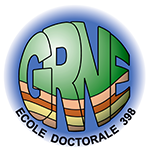Séminaire ISTeP - Anne Le Friant
(IPGP)
Submarine record of volcanic island construction and collapse in the Lesser Antilles: First scientific drilling of submarine volcanic island landslides by IODP Expedition 340
IODP Expedition 340 successfully drilled a series of sites offshore Montserrat, Martinique and Dominica in the Lesser Antilles from March-April 2012. These are some of the few drill sites around volcanic islands, and this was the first scientific drilling of large and potentially tsunamigenic volcanic island-arc landslides. Drilling recovered some of the most sand-rich sequences yet collected by scientific drilling. These cores were able to ground-truth and test previous hypothesis for the composition of volcanic island landslides.
For instance, it has been proposed that emplacement of volcanic debris avalanches, comprising material from the subaerial and submarine flanks of the volcano, can cause widespread and voluminous failure of surrounding low-gradient seafloor sediment. The Expedition 340 sites (U1394, U1399, and U1400) that penetrated volcanic island landslides recovered exclusively seafloor-sediment, comprising mainly parallel bedded turbidites and hemipelagic mud, and lacked debris avalanche deposits. This confirms that widespread and voluminous failures of pre-existing seafloor sediment can be triggered by initial emplacement of material from the volcanic edifice. Offshore Martinique (Sites U1399 and 1400) the landslide deposits comprised panel of parallel strata that were tilted or micro-faulted, sometimes separated by intervals of homogenised sediment that record multiple layers of intense shear.
However, Site U1394 offshore Montserrat penetrated a flat-lying block of intact strata. These results have important implications for the magnitude of tsunami generation. Volcanic island landslides comprising mainly seafloor sediment will tend to form smaller magnitude tsunamis.
Expedition 340 also successfully drilled a series of sites outside landslide deposits to capture eruption fallout layers, thereby providing an outstanding high-resolution dataset with which to understand eruption cycles, magma evolution and the long term growth and decay of volcanic islands, including sedimentation processes.
07/11/2014 à 12h30, Salle Fourcade (Tour 55/56, 4ème étage)
Egalement dans la rubrique
- Séminaire ISTeP - Chrystèle Sanloup
- Séminaire ISTeP - Marco Scambelluri
- Séminaire ISTeP - Déborah Chavrit
- Séminaire ISTeP - Evgueni Burov
- Séminaire ISTeP - Pierre Valla
- Séminaire ISTeP - Ramadan Ghalayini
- Séminaire ISTeP - Matthias Delescluse
- Séminaire ISTeP - Séverine Moune
- Séminaire ISTeP - Lucie Tajcmanova
- Séminaire ISTeP - Gabriel Coelho
- Séminaire ISTeP - Laurie Bougeois
- Séminaire ISTeP - Jacques Touret
- Séminaire ISTeP - Sanae El Janyani
- Séminaire ISTeP - Arthur Paté
- Séminaire ISTeP - Nicolas Beaudoin
- Séminaire ISTeP - Kosuke Ueda
- Séminaire ISTeP - Ali Hannouche
- Séminaire ISTeP - Benjamin Cochain
- Séminaire ISTeP - Behzad Nasri
- Séminaire ISTeP - Daniel Pastor Galan
- Séminaire ISTeP - Sara Lafuerza Colas
- Séminaire ISTeP - Jean-Pierre Suc
- Séminaire ISTeP - Pierpaolo Zuddas
- Séminaire ISTeP - Agnès Elmaleh
- Séminaire ISTeP - John Wakabayashi
- Séminaire ISTeP - Jonas Ruh
- Séminaire ISTeP - Timm John
Chiffres clés (Mars 2025)
L'ISTeP comprend 131 membres dont :
Permanents (66)
- Professeurs : 17 (+2 PAST)
- Maîtres de conférence : 26
- Directeurs de recherche CNRS : 1
- Chargés de recherche CNRS : 1
- ITA : 19
Personnels non permanents (65)
- Collaborateurs bénévoles / émérites : 17
- Chaire de professeur junior : 1
- Enseignants-chercheurs contractuel : 2
- 1 MCF accueil en délégation
- ATER et Post-Docs : 9
- Doctorants : 32
- ITA-BIATSS : 3





